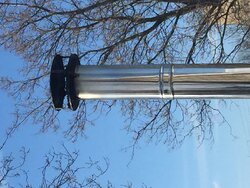I burned two cords of 2 year seasoned mixed hardwoods and 1 cord of compressed wood bricks this winter (thus far). Brand new setup with blazeking princess insert, poured insulation liner, burned 24/7 for last 4.5 months. The chimney cap was brand spanking new and shining, but now it is black and looks like its covered in creosote. I though the catalytic combusters prevented creosote. Also, 99.9% of the time I burn there is only a small wisp of white looking smoke, so why is this happening? I'm afraid to burn more for fear of chimney fire.
Help. Creosote buildup on chimney cap, first full-year burn.
- Thread starter Ricky8443
- Start date
-
Active since 1995, Hearth.com is THE place on the internet for free information and advice about wood stoves, pellet stoves and other energy saving equipment.
We strive to provide opinions, articles, discussions and history related to Hearth Products and in a more general sense, energy issues.
We promote the EFFICIENT, RESPONSIBLE, CLEAN and SAFE use of all fuels, whether renewable or fossil.



 haha, j/k
haha, j/k